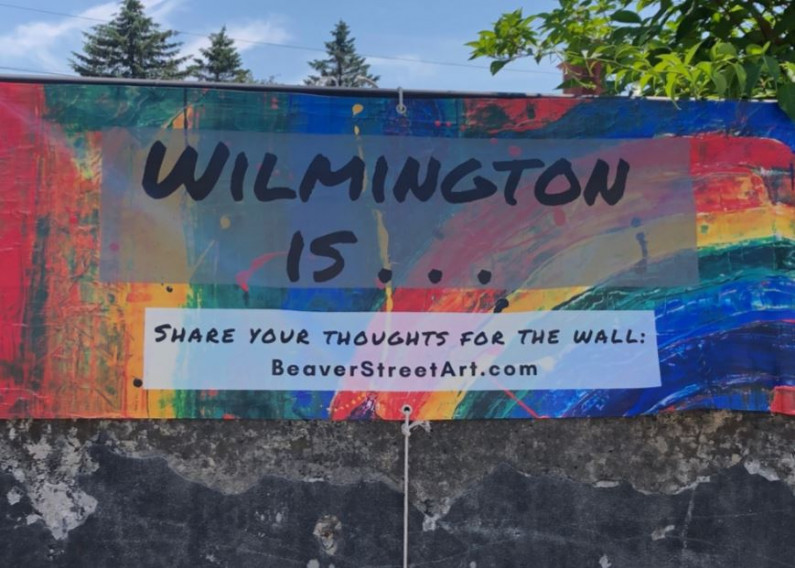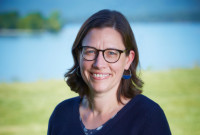A Q+A with Program Officer Kate McCarthy on the Better Places Partnership

A mural, the small park in a village, or those parking spaces converted into dining areas—these are all spaces that facilitate gathering and the feeling like we are part of something.
The Better Places Partnership is a new program in Vermont that is designed to help communities create these spaces. What started as a pilot initiative—between the Vermont Agency of Commerce and Community Development (ACCD), Vermont Department of Health, the Vermont Arts Council, the National Life Group Foundation, the Preservation Trust of Vermont, and the Vermont Community Foundation—is now a full-fledged program to support placemaking projects that provide opportunities to participate in community-improvement efforts. According to the Project for Public Spaces, placemaking inspires people to collectively reimagine and reinvent public spaces as the heart of every community.
Community Foundation—is now a full-fledged program to support placemaking projects that provide opportunities to participate in community-improvement efforts. According to the Project for Public Spaces, placemaking inspires people to collectively reimagine and reinvent public spaces as the heart of every community.
We caught up with Kate McCarthy, Program Officer on our Grants and Community Investments team, to learn more about the development of the program and the Community Foundation’s role.
Who is involved in the Better Places Partnership and what is the stated goal?
The Better Places Partnership is a great example of what can happen when philanthropy and government work together. Better Places was initiated as a pilot project a few years ago. It was considered a success when 63 communities responded to a request for applications, yet there was only enough funding for eight—indicating both interest and need.
Because of this, the Agency of Commerce and Community Development was able to secure state funding with help of the Vermont Legislature and Governor Scott to grow the pilot into a more impactful program. The philanthropic dollars that funded the pilot, including dollars from the Community Foundation, minimized risk and proved the value of the program—a true example of how philanthropy can fuel innovation.
Fast forward to today, and we’re working with ACCD, as well as the Vermont Department of Health and a company called Patronicity, to implement Better Places on a broader scale. Our goal is to create inclusive and vibrant public spaces in downtowns, villages, and neighborhoods in all corners of Vermont.
Interesting—and how does the Partnership plan to do that?
It is going to be quite different than typical grant programs, where we accept applications to evaluate and then make awards. The model we are aiming for is community-led, place-based, economic development driven by a “crowdgranting” approach.
I’ve never heard of “crowdgranting.” Can you explain?
Definitely. The first thing to explain is that this is a true public-private partnership between two state agencies—Commerce and Community Development and Department of Health, the Community Foundation, Patronicity, and any town or community in Vermont that has an idea for a placemaking project. If you’re familiar with crowdfunding (think—Kickstarter or a Go Fund Me campaign as examples), crowdgranting works in a similar way.
Vermont towns and communities that are interested in pursuing a placemaking project will work with the Partnership to understand if their project is at a point where it’s ready to raise money for implementation. Once that is the case, a profile for the project will be created on the Better Places crowdfunding platform managed by Patronicity, a company that provides one-on-one project coaching—helping towns of different sizes and populations. They also provide a website where supporters can then go to contribute money towards the project—even $5, though because it’s community-oriented, no one person can contribute more than 35% of the campaign goal. Based on the total cost of the project, a target will be set for the funding that needs to be raised by the community—equal to one-third of the total cost. As soon as that target is hit, the project will receive double the amount the community raises (the remaining cost) in state funding to reach the full amount needed to make the project a reality.
This is a unique model that has never been tested in Vermont before. What I like is it gets community members involved in the project—first when it’s being developed, then as people learn more during the fundraising campaign, and then, if people choose, as donors. These different stages plus a fundraising approach that succeeds based on a lot of small contributions help make each individual project one that’s shared by the people who live there. And of course, once the project exists, it provides a place for all community members to gather and celebrate.
And what will be the Community Foundation’s role?
We are helping bring together the funding sources and get them out to communities once the crowdgranting goal is met and the state funding is unlocked. At the same time, we are collecting data on how this type of grantmaking can be effective in our communities.
What does success look like for the Better Places Partnership and how will it make Vermont better for all Vermonters?
These projects are all about building or enhancing public spaces and places that both reflect the communities they are in and welcome the people who make up that community. On top of that, these are places where people interact, perhaps with someone who they may not otherwise cross paths with—creating a sense of belonging in a shared place.
These placemaking projects and resulting public spaces are designed to build social capital—what we all need to enjoy our lives, solve big and small community problems, and be better neighbors. Also, when I think of the Better Places Partnership, and the types of public spaces the program aims to create, the words, “welcoming, inclusion, belonging, and connection” come to mind, because well-designed public spaces can make that happen. Those are words that sound like a Vermont that is better for all Vermonters.
What hurdles currently stand in the way of success and how does the Partnership plan to address them?
We need to get the word out! Our next big push is helping communities across the state find out about the Better Places program and get ready to apply. What’s important in this push is to get a wide geographic distribution—we want communities of all sizes and types to participate.
Whether they have a town manager or are in a rural area, every community has good ideas, and it is really important for communities to feel like this initiative is for them. I am also excited to see the ways that communities of different sizes think carefully about developing projects where all people feel they can participate safely and easily, regardless of where they’re from, what they look like, or how easily they are able to get around. It’s a great opportunity for accessible spaces where people feel a sense of belonging.
How can the Community Foundation’s partners support the Better Places Partnership?
Anyone who is interested in the Better Places program should attend an informational webinar on Thursday, February 10, 2022, at 11:00 a.m. REGISTER HERE.
In addition, keep your ears open in your community for projects that have been bubbling along for months or years and are now ready to take the next step towards implementation—this program could be your program!
Share with decision-makers in your community. Get the word out to people who may not always think of themselves as people who can access public grant dollars. Make this project really reflective of your community and the people who live there.
And keep an eye out for crowdgranting opportunities coming to a town near you!
To learn more about the Better Places Partnership, including how to register for the webinar on February 10th, visit the Better Places website.